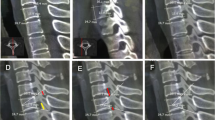Abstract
Introduction
Proximal junctional kyphosis (PJK) of the cervicothoracic spine is a deformity that can affect patients who have undergone long thoracolumbar instrumented fusion. Preoperative hyperkyphosis of the thoracic spine and changes of more than 30° in lumbar lordosis are independent risk factors for the onset of PJK.
Methods
When PJK occurs in the cervicothoracic spine, extension of the fusion with eventual application of osteotomy techniques is frequently necessary to treat symptomatic patients or in case a neurological deficit occurs. Ponte osteotomy and pedicle subtraction osteotomy (PSO) are the two most used techniques to restore a good cervicothoracic alignment, although they are still demanding procedures even for expert surgeons. In junctional fractures, a vertebral column resection can be performed to support the anterior column. Ponte osteotomy ideally restores 10° at each treated level, while PSO allows a segmental correction up to 30°–35°. Adequate preoperative planning is fundamental for outlining the correct surgery and choosing the appropriate osteotomy.
Conclusions
The aim of corrective surgery is to restore the cervicothoracic alignment, obtaining an adequate postoperative sagittal balance and decreasing the risk of further complications and new revision surgeries.



Similar content being viewed by others
References
Arlet V, Aebi M (2013) Junctional spinal disorders in operated adult spinal deformities: present understanding and future perspectives. Eur Spine J 22(Suppl 2):S276–S295
Denis F, Sun EC, Winter RB (2009) Incidence and risk factors for proximal and distal junctional kyphosis following surgical treatment for Scheuermann kyphosis: minimum five-year follow-up. Spine Phila Pa (1976) 34:E729–E734
DeWald CJ, Stanley T (2006) Instrumentation-related complications of multilevel fusions for adult spinal deformity patients over age 65: surgical considerations and treatment options in patients with poor bone quality. Spine Phila Pa (1976) 31:S144–S151
Hart RA, Prendergast MA, Roberts WG et al (2008) Proximal junctional acute collapse cranial to multi-level lumbar fusion: a cost analysis of prophylactic vertebral augmentation. Spine J 8:875–881
Hollenbeck SM, Glattes RC, Asher MA et al (2008) The prevalence of increased proximal junctional flexion following posterior instrumentation and arthrodesis for adolescent idiopathic scoliosis. Spine Phila Pa (1976) 33:1675–1681
Watanabe K, Lenke LG, Bridwell KH et al (2010) Proximal junctional vertebral fracture in adults after spinal deformity surgery using pedicle screw constructs: analysis of morphological features. Spine Phila Pa (1976) 35:138–145
Kim YJ, Bridwell KH, Lenke LG et al (2008) Proximal junctional kyphosis in adult spinal deformity after segmental posterior spinal instrumentation and fusion: minimum five-year follow-up. Spine Phila Pa (1976) 33:2179–2184
Maruo K, Ha Y, Inoue S et al (2013) Predictive factors for proximal junctional kyphosis in long fusions to the sacrum in adult spinal deformity. Spine Phila Pa (1976) 38(23):E1469–E1476
Kim HJ, Lenke LG, Shaffrey CI et al (2012) Proximal junctional kyphosis as a distinct form of adjacent segment pathology after spinal deformity surgery. Spine Phila Pa (1976) 37(22S):S144–S164
Glattes RC, Bridwell KH, Lenke LG et al (2005) Proximal junctional kyphosis in adult spinal deformity following long instrumented posterior spinal fusion: incidence, outcomes, and risk factor analysis. Spine Phila Pa (1976) 30:1643–1649
Wang MY, Berven SH (2007) Lumbar pedicle subtraction osteotomy. Neurosurgery 60(2 Suppl 1):ONS140–ONS146
Boyle JJ, Milne N, Singer KP (2002) Influence of age on cervicothoracic spinal curvature: an ex vivo radiographic survey. Clin Biomech (Bristol, Avon) 17:361–367
Simmons EH (1972) The surgical correction of flexion deformity of the cervical spine in ankylosing spondylitis. Clin Orthop 86:132–143
Ponte A, Vero B, Siccardi GL (1984) Surgical treatment of Scheuermann’s hyperkyphosis. In: Winter RB (ed) Kyphosis (progress in spinal pathology). Aulo Gaggi, Bologna, pp 75–80
Lamartina C, Berjano P (2014) Classification of sagittal imbalance based on spinal alignment and compensatory mechanisms. Eur Spine J 23:1177–1189
Conflict of interest
None.
Author information
Authors and Affiliations
Corresponding author
Rights and permissions
About this article
Cite this article
Cecchinato, R., Berjano, P., Bassani, R. et al. Osteotomies in proximal junctional kyphosis in the cervicothoracic area. Eur Spine J 24 (Suppl 1), 31–37 (2015). https://doi.org/10.1007/s00586-014-3654-7
Received:
Revised:
Accepted:
Published:
Issue Date:
DOI: https://doi.org/10.1007/s00586-014-3654-7




